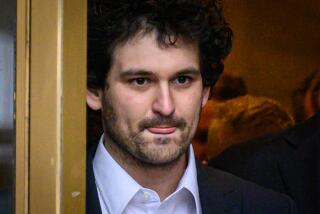Nasdaq Studies May Prove Academic : Wall Street: Legal experts say hard evidence is what will matter most in collusion probes.
- Share via
NASHVILLE, Tenn. — Nasdaq and its critics are battling each other with conflicting studies by business professors over whether its dealers collude to fix stock prices. But in the end, the war of white papers is likely to prove purely academic, legal experts said Thursday.
At a conference at Vanderbilt University, professors and economists summarized studies they say refute one released last May that concluded there was “tacit collusion” among Nasdaq dealers to widen the quoted spreads on stocks--essentially, the dealers’ profit margin.
That study, by business school professors William Christie and Paul Schultz, set off a chain of events that has led to two federal investigations of Nasdaq and a number of investor lawsuits.
The biggest of several guns shooting back at the study is Christie’s and Schultz’s one-time professor at the University of Chicago, Nobel laureate Merton H. Miller.
Miller held back little in castigating his former pupils Thursday, insisting that the Nasdaq market “is unquestionably competitive.”
“The Christie-Schultz paper is not only flawed, but has set off a flood of socially wasteful lawsuits, possibly harmful intervention by regulatory officials and even by nervous Nasdaq officials who are anxious to protect their tails against a backlash,” said Miller, whose study was financed by Nasdaq.
In any event, attorneys involved in the lawsuits and in investigations by the Justice Department’s antitrust division and the Securities and Exchange Commission said that what will matter most in court is hard evidence, not studies.
Sources confirmed that both the SEC and Justice Department are reviewing thousands of hours of subpoenaed tapes of telephone conversations between Nasdaq dealers. They are sifting out what they believe are numerous explicit attempts to fix spreads, or threats against dealers who broke ranks to narrow the spreads.
Spreads are the gap between the “bid” price, at which a dealer offers to buy a stock, and the higher “asked” price, at which a dealer offers to sell.
Investigators are also reviewing stacks of documents and taking the statements of witnesses, including a number of dealers who have come forward to say they were the victims of threats or retaliation for narrowing spreads.
One non-academic who spoke at the Vanderbilt conference said he had experienced such pressure.
Blair Hull, managing partner of Hull Trading Co. in Berkeley, said that in April, 1994, his firm narrowed the spread of Snapple Beverage Corp. to 1/8, or 12.5 cents, from 1/4, or 25 cents.
“We immediately got calls (from other dealers) saying . . . ‘You’re ruining our game,’ ” Hull said.
Arthur Kaplan, one of the lead lawyers in a federal class-action lawsuit filed on behalf of investors against 33 big Nasdaq dealers, said academic studies will matter little in the suit. “There’s going to be a great deal of direct evidence of active collusion,” he said, adding that his case will rise or fall on such evidence.
But Nasdaq and its dealers plainly are hoping they can restore the market’s tarnished image--and, perhaps, eventually persuade juries--with the help of studies. The market has commissioned two independent studies by separate groups of economists so far; Miller said he spent 20 to 30 hours on his contribution to one of the studies.
A Nasdaq spokesman declined to say how much the economists will be paid.
The Christie-Schultz report emerged after the two professors noticed an oddity while reviewing Nasdaq trading data. Many of the largest Nasdaq stocks, they saw, were never quoted by dealers in “odd-eighth” prices. That is, the stocks might be quoted at 20 or 20 1/4 or 20 1/2, but never at 20 1/8, 20 3/8 and so on. The result was that the spreads on these stocks could never be less than one-fourth. By contrast, most stocks on the New York Stock Exchange have spreads of one-eighth. The two professors concluded that the only reasonable explanation for the phenomenon was tacit collusion among Nasdaq market makers, as its dealers are known.
In reviewing the study Thursday, Christie noted that it found that Apple Computer stock was not quoted in odd-eighths at any point in 1991.
“How could it be that over the course of a year, 60 market makers simply forgot to use half of the possible price fractions?” Christie said. “I don’t think they did forget.”
But Miller said he had found that other markets--including the London Stock Market, the London Gold Market and foreign currency exchange markets--also showed a tendency to cluster around certain fractions but not others.
Dean Furbush, the author of another study done on Nasdaq’s behalf, contended that Nasdaq pricing is fully competitive, because there are no barriers to additional dealers coming in to make markets in any Nasdaq stock they choose.
*
Nasdaq Investigation
* The entire six-part series “Inside Nasdaq” is available under “Special Reports” in the Business section on the TimesLink on-line service. Reprints of the series are available from Times on Demand for $10.45 each. Call 808-8463, press *8630. Select Option 1. Order Item No. 8525.
Details on Times electronic services, B4
More to Read
Inside the business of entertainment
The Wide Shot brings you news, analysis and insights on everything from streaming wars to production — and what it all means for the future.
You may occasionally receive promotional content from the Los Angeles Times.










